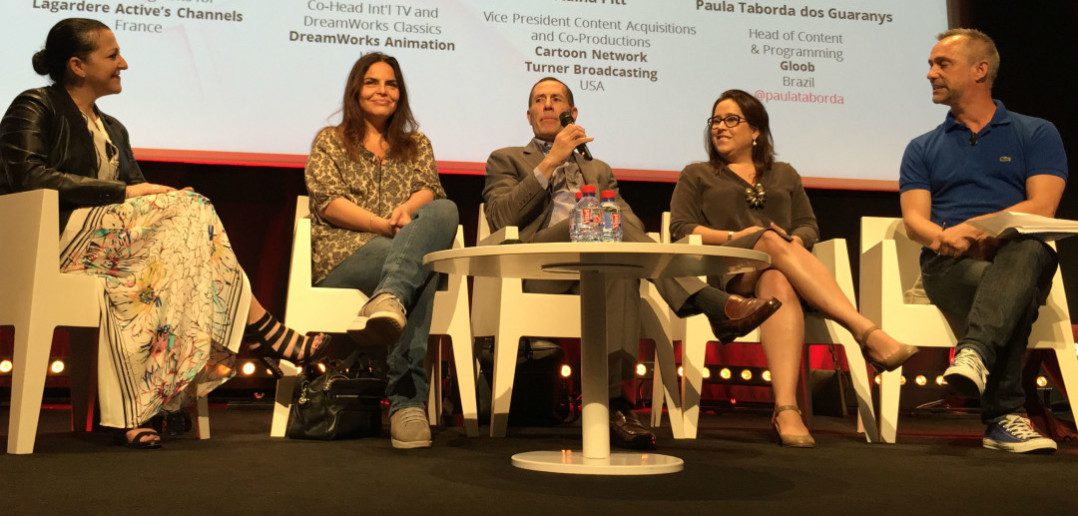It’s a fascinating time to be in the children’s entertainment market – albeit a slightly worrying one if you’re a broadcaster, with constant speculation about the extent to which children’s attention is drifting to games and online video, and whether advertising revenues will follow them.
Today, a panel of children’s TV execs discussed the market, as well as their budgets, projects and targets for the year ahead. The panel included Adina Pitt, vice president of content acquisitions and co-productions for Cartoon Network; Caroline Cochaux, head of programs for Lagardere Active’s channels; Eric Ellenbogen, co-head of international TV and DreamWorks Classics at DreamWorks Animation; and Paula Taborda dos Guaranys, head of content and programing at Gloob in Brazil. The moderator was author and consultant Christophe Erbes.
« Two years ago, DreamWorks was really not in the television business, » said Ellenbogen, describing « really the most remarkable ramp-up » since then, to the point where it’s launching the DreamWorks Channel, aimed mainly at Asia. « Not only have we catapulted into the television business: now we’re going into the channel business, which is really interesting and different for us. » He stressed that outside Asia, DreamWorks’ strategy remains partnerships with free-to-air and pay-TV channels.
« One of the things that’s emergent is that it’s about all rights. We’re generally finding partners in the territory and affiliates who have free-to-air, paid television, second-screen, OTT services etc. We’re finding that though we are the youngest and newest launch in the territory, by having all these rights we don’t have any of the legacy issues that prevent flexibility in working with telecasters, » said Ellenbogen.
DreamWorks is starting the channel with its own content, but will it acquire shows in the future? « We want to be appropriate to the region, so as a result we’re looking for acquisitions to place on the channel so it has a local flavour. We’re not trying to be one-size suits all, » he said.
DreamWorks also has a strong relationship with Netflix elsewhere in the world. « We think of it in some places almost as pay television, so it’s a first window, » he said. « It’s an exciting development because they’ve been just a huge driver of production, and bringing things to audiences that they’ve never seen before. »
Could DreamWorks take its channel to other continents? « This for us is sort of a first effort. One of the things that’s been interesting about building this channel is all of the other assets we’re building that go along with the channel: all of the assets for the second screen, the website, the games… We’re interested in the idea of whether this can exist in other markets, » he said.
Who are the channel’s main competitors? « We will in all likelihood live in the same ecosystem as our friends at Nickelodeon and Disney and Cartoon [Network], but the thing that we’re finding is it’s driven by the specific shows… the audience is finding content that they love irrespective of where it comes from. Great content is our competition, and I’m not sure it aligns itself in any particular channel… Great content is the competition, and that’s the best kind of competition. »
He admitted that he greatly admires what Cartoon Network does in Asia – « They’ve been really remarkable in engagement on second screens and in the way they’ve used the content… the ones that succeed actually stand for something, so it’s not just a mish-mosh. It’s not just content for content’s sake. »
Lagardere’s Cochaux spoke next about the three kids’ channels she runs: Gulli is the biggest children’s TV channel in France: « It appears that 98% of the kids watch Gulli in France, which is big, » she said of the free digital channel. The other two are pay-TV channels: Canal J for 6-12 year-olds, launched in 1985, and Tiji for 3-7 year-olds, which is 15 years old.
« The strategy we’re doing is as we have those pay-TV channels, we will first launch our premium series on the pay-TV… and then six months or a year after they will be on Gulli, » she said. The company has around 30 shows in production across the three channels. « We try to have two channels each time for each co-production, so it means we are alone in France to air those shows, » she said. Although Tiji does carry some shows for its pay window that then go to free-to-air channels other than Gulli.
What works well for Lagardere’s channels? « I believe the French channel that’s winning is Gulli because it’s the only DTT free channel for kids in France, » she said, noting that this brings with it obligations of production. « It has to be French, » she said. « For example, Sonic Boom was launched first in Canal J, and is going to be in Gulli in September, and it’s already a tremendous hit in France. The children are really fond of this one. »
How can kids’ TV reach children older than nine years old? Lagardere is somehow managing, noted Herbe. How? « We’re sassy, » said Cochaux. « We have this way to speak to kids which is not only like they are kids. They start at the age of nine, ten to have their own sense of humour and to be really funny… We don’t really speak to them as children. We are talking to them as grown-ups. » She added that Gulli’s official app has been downloaded 2m times in France, and said she’s not scared by the launch of YouTube Kids as a competitor. « No, we do have our channel on YouTube. We’re not scared, we’re all working together! » she said.
Over to Paula Taborda dos Guaranys from Gloob in Brazil. It launched three years ago: « In Brazil we are the new kid on the block, » she said, before showing some stats on pay-TV penetration in Latin America: 40% overall in 2014, including an estimated 61m viewers in Brazil, where pay-TV is in 30% of households, and Gloob in 70% of those. The channel has a mixture of acquisitions (including Angry Birds) and original Brazilian content, with live-action and animated shows: nine and 10 in development respectively.
« As we are competing with big guys who’ve been in the market for 20 years or so, we want to do some co-productions, and get on board earlier than the other channels so we could guarantee some great productions for Brazil, » she said, citing two shows – Paper Port and Trullalleri – as examples. It has 15 free apps with more than 1.7m downloads, and 20m views on its video on demand (VOD) service. And Gloob also has a catalogue of 120 online games for its young viewers to play.
« The whole idea with the live-action and animated shows is that in order to do the 360 strategy, for the live action shows we do a digital identity for each character and the scenarios, so we can transfer these drawings to the apps and games, » she said. But Guaranys went on to admit that Gloob is « very picky » about the shows it commissions: « We always try to improve the scripts! » she said.
Finally, Adina Pitt from Cartoon Network, who talked about her channel’s growth and strategy with its mixture of own-IP and acquisitions. « There’s been a content strategy that took several years to formulate, » she said. « The reality is that there’s a lot of strategy, a little bit of luck and a lot of hard work… We try to complement what we’re bringing in from an original standpoint with shows that feel like a bit of a departure from what we’re making. It’s very common that we’re pitched shows that are very similar to what we have… but if we have it, why would we license it? We don’t want Adventure Time-like. We want something different. »
She praised Lego as a partner delivering something different with its Lego Ninjago series – « A great moment for both companies, I think » – but quickly moved on to digital disruption. « As you try to be where all of your audience is, you have to maximise all of those different platforms that you have: your nonlinear strategy today is as important as your linear strategy… We’re launching our first nonlinear series this year… This generation is there [online]and we have to be there with them. »
She addd that a big challenge for Cartoon Network is the need to continually innovate « when you have challenged budgets sometimes » – including the need to get out of the office and meet new creators and producers who may have the ideas that can work within those budgetary restrictions. « We’re living in a world where there’s more competition than ever. Everybody’s the competition: kids have a lot of choice, and there’s a lot of brands, a lot of great brands. So we’re living in a world where we have to invite people in, » she said.
« Boys are easily distracted. They have a lot of interests: they’re watching you, they’re playing you, they’re consuming you in so many different ways. We’ve become so interested, more than ever before, in researching their behaviour and trying to get in front of it. »
How does Pitt feel about the explosion in children watching YouTube channels like Stampy, which are focused on games like Minecraft? « There’s a new pool of celebrity talent out there of unknown people that has exploded. We have a dedicated team of people out there looking for talent that exists in the online world, » she said. « How do I feel about YouTube? Competition is great, and it makes us innovate maybe a little bit faster than we otherwise would have! » she said.
Check out MIPTV, MIP Digital Fronts, MIPDoc & MIPFormats 2015 full live coverage




